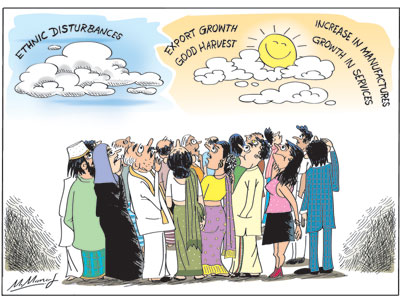Columns
Silver linings in the economy: Increased agricultural and industrial production and export growth
View(s):Despite the recent gloom cast by the communal violence that threatened several key sectors of the economy, there are some bright spots emerging in the economy. Improved paddy harvests, prospects of increased tea production, increased industrial production and a further growth in exports are favourable developments that should result in higher economic growth this year.
 On the other hand, the setback to tourism, decreasing remittances, lower foreign investment and possible net capital outflows will affect the economy adversely. The sooner peaceful conditions are established and confidence generated in the country these drawbacks could be mitigated.
On the other hand, the setback to tourism, decreasing remittances, lower foreign investment and possible net capital outflows will affect the economy adversely. The sooner peaceful conditions are established and confidence generated in the country these drawbacks could be mitigated.
Economic populism
Economic growth in the next few years could be seriously affected owing to the government’s economic policies being geared to gain popularity. Economic populism could have an adverse impact on mid and long run economic growth, especially owing to an increase in the fiscal deficit. Fiscal slippage and lack of essential reforms may jeopardise midterm economic growth.
Agriculture
Agricultural production is likely to revive owing to better paddy and food crop production, as well as increased tea production on estates and small holdings. Coconut output may not increase by much owing to the lag effect of the drought.
Good harvests
After two years of floods and drought that brought down paddy and food crop production drastically and necessitated rice imports, indications are that the 2018 maha harvest that is being reaped these days would be a good, though not a bountiful one. The maha harvest is expected to be 2.32 million kilograms. It is 57 percent higher than the depressed output of last year, but 17 percent less than the maha harvest of 2015/16.
 The likely good weather this year, the better distribution of fertiliser and subsidies are likely to boost the yala harvest. The yala crop is likely to be much higher than in recent years. This year’s paddy production is forecast to reach 601 metric tons compared to only 543 metric tons last year. In 2016 paddy production was a record 766 metric tons.
The likely good weather this year, the better distribution of fertiliser and subsidies are likely to boost the yala harvest. The yala crop is likely to be much higher than in recent years. This year’s paddy production is forecast to reach 601 metric tons compared to only 543 metric tons last year. In 2016 paddy production was a record 766 metric tons.
Respite
Increased food production is a relief to the economy as it implies reduced imports of rice and wheat this year and a decrease in rice prices that soared last year. Apart from the advantages to the economy, good harvests mean better incomes to the rural community and a relief to the livelihoods of a substantial proportion of the county’s population. The reduction in food prices would also be a boon to the lower income sections of the population. Inflation is expected to decelerate to about 5 percent later this year.
Tea
There is an expectation of higher tea production owing to better weather and the availability of fertiliser and weedicides. The increased tea production is likely to be mostly from smallholdings in the south. The consequent increase in the exportable tea surplus should improve export earnings provided international tea prices remain at current levels. The current predictions are that prices would be steady at around last year’s attractive levels.
Tea exports
In keeping with the increasing trend in exports later last year, tea exports grew by 11 percent to US$111 million in January this year. Hopefully this trend would gain momentum with the expected higher production of tea.
Industrial production
There was a significant industrial growth in the fourth quarter of last year. The growth in ceramics, garments, rubber and leather goods is likely to continue as this growth, stimulated by better export prospects is expected to grow during the course of the year.
The Central Bank’s Purchasing Managers’ Index (PMI) Survey disclosed that manufacturing and service sectors expanded at a higher rate in February 2018, compared to the previous month. Several sub-indices too disclosed a growth.
Services
A steeper gain was observed in the business activities of the financial services, IT programming and transportation of goods and warehousing sectors. Service providers’ optimism on the three-month business outlook also strengthened at a modest pace.
Export growth
Export growth that commenced in March last year has been gaining momentum. In 2017 exports increased by 11.4 percent and this trend is continuing with an export growth of 6.2 percent in January. Exports of rubber and finished rubber products increased by 19 percent to earn US$75 million.
The Export Development Board (EDB) expects exports to increase to US$15 billion. An export value of US$13 billion that is more realistic would be significant. The EDB expects growth in industrial exports, mostly garments and textiles, ceramics, rubber and leather goods, to result in total exports of US$15 billion. Much of this expectation of export growth is based on the improving trend in exports over the last months and the export growth in January this year of 6.23 percent to US$934 million. The government’s target is to achieve exports of one billion in each month.
Textiles and garments
Apparel and textile exports grew by a modest 1.8 per cent to reach US$433 million in January. However, a double digit growth is expected in apparel exports in the coming months as apparel exporters were fulfilling orders received prior to getting the GSP plus. Sri Lanka’s textile and garments exports exceeded US$5 billion during 2017, its highest-ever value for a single year, recording a 3 per cent growth compared to US$4.88 billion a year ago. The Sri Lanka Apparel Exporters Association targets US$8 billion in apparel exports by 2022.
Summing up
While there are some economic gains this year, these should not blind us to the loss due to the communal violence that could affect the economy adversely for some time. Every effort must be made to build confidence, peaceful conditions and law and order in the country to restore tourism. Any recurrence would be the death knell to this valuable source of foreign exchange earnings.
Investment both foreign and domestic have been adversely affected. Restoring confidence among foreign investors is an uphill task, and without larger amounts of FDI in manufactures, the country’s export capacity cannot be enhanced.
The setback to the economy cannot be reversed easily. While the gains in economic growth this year is a relief, the longer term growth remains below the needed momentum. Furthermore populist economic policies could destabilise the economy and retard economic growth.


Leave a Reply
Post Comment